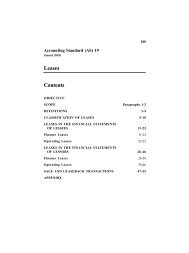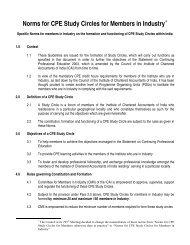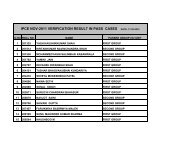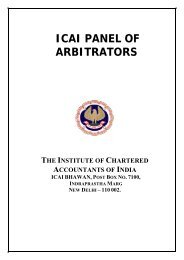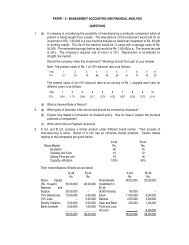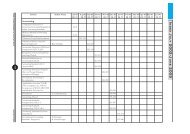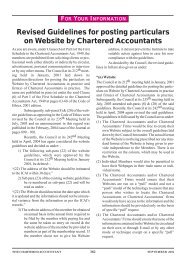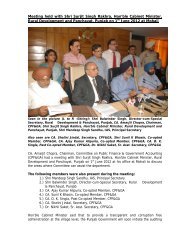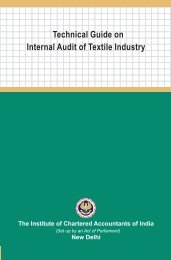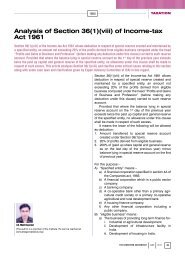The Chartered Accountant
The Chartered Accountant
The Chartered Accountant
You also want an ePaper? Increase the reach of your titles
YUMPU automatically turns print PDFs into web optimized ePapers that Google loves.
further into the future, in considering<br />
events or conditions further in the future,<br />
the indications of going concern<br />
issues need to be significant before the<br />
auditor needs to consider taking further<br />
action. If such events or conditions are<br />
identified, the auditor may need to request<br />
management to evaluate the potential<br />
significance of the event or condition<br />
on its assessment of the entity’s<br />
ability to continue as a going concern.<br />
In these circumstances the procedures<br />
in paragraph 16 apply.<br />
A14. Other than inquiry of management,<br />
the auditor does not have a responsibility<br />
to perform any other audit<br />
procedures to identify events or conditions<br />
that may cast significant doubt on<br />
the entity’s ability to continue as a going<br />
concern beyond the period assessed by<br />
management, which, as discussed in<br />
paragraph 13, would be at least twelve<br />
months from the date of the financial<br />
statements.<br />
Additional Audit Procedures When<br />
Events or Conditions Are Identified<br />
(Ref: Para. 16)<br />
A15. Audit procedures that are relevant<br />
to the requirement in paragraph<br />
16 may include the following:<br />
l Analysing and discussing cash<br />
flow, profit and other relevant<br />
forecasts with management.<br />
l Analysing and discussing the<br />
entity’s latest available interim<br />
financial statements.<br />
l Reading the terms of debentures<br />
and loan agreements and<br />
determining whether any have<br />
been breached.<br />
l Reading minutes of the meetings<br />
of shareholders, those<br />
charged with governance and<br />
relevant committees for reference<br />
to financing difficulties.<br />
l Inquiring of the entity’s legal<br />
counsel regarding the existence<br />
of litigation and claims and<br />
the reasonableness of management’s<br />
assessments of their<br />
outcome and the estimate of<br />
their financial implications.<br />
l Confirming the existence, legality<br />
and enforceability of arrangements<br />
to provide or maintain financial<br />
support with related and<br />
third parties and assessing the<br />
13 See footnote 10<br />
DECEMBER 2008 1106 THE CHARTERED ACCOUNTANT<br />
STANDARDS<br />
financial ability of such parties<br />
to provide additional funds.<br />
l Evaluating the entity’s plans to deal<br />
with unfilled customer orders.<br />
l Performing audit procedures<br />
regarding subsequent events<br />
to identify those that either<br />
mitigate or otherw ise affect the<br />
entity’s ability to continue as a<br />
going concern.<br />
l Confirming the existence, terms<br />
and adequacy of borrowing facilities.<br />
l Obtaining and reviewing reports<br />
of regulatory actions.<br />
l Determining the adequacy of<br />
support for any planned disposals<br />
of assets.<br />
Evaluating Management’s Plans<br />
for Future Actions (Ref: Para. 16(b))<br />
A16. Evaluating management’s plans<br />
for future actions may include inquiries<br />
of management as to its plans for future<br />
action, including, for example, its<br />
plans to liquidate assets, borrow money<br />
or restructure debt, reduce or delay expenditures,<br />
or increase capital.<br />
<strong>The</strong> Period of Management’s Assessment<br />
(Ref: Para. 16(c))<br />
A17. In addition to the procedures required<br />
in paragraph 16(c), the auditor<br />
may compare:<br />
l <strong>The</strong> prospective financial information<br />
for recent prior periods<br />
with historical results; and<br />
l <strong>The</strong> prospective financial information<br />
for the current period<br />
with results achieved to date.<br />
A18. Where management’s assumptions<br />
include continued support by<br />
third parties, whether through the<br />
subordination of loans, commitments<br />
to maintain or provide additional<br />
funding, or guarantees, and such support<br />
is important to an entity’s ability<br />
to continue as a going concern, the<br />
auditor may need to consider requesting<br />
written confirmation (including<br />
of terms and conditions) from those<br />
third parties and to obtain evidence of<br />
their ability to provide such support.<br />
Audit Conclusions and Reporting<br />
(Ref: Para. 17)<br />
A19. <strong>The</strong> phrase “material uncertainty”<br />
means the uncertainties related to<br />
events or conditions which may cast<br />
significant doubt on the entity’s ability<br />
to continue as a going concern that<br />
should be disclosed in the financial<br />
statements. In some other financial<br />
reporting frameworks the phrase “significant<br />
uncertainty” is used in similar<br />
circumstances.<br />
Use of Going Concern Assumption<br />
Appropriate but a Material<br />
Uncertainty Exists<br />
Adequacy of Disclosure of Material<br />
Uncertainty (Ref: Para. 18)<br />
A20. <strong>The</strong> determination of the adequacy<br />
of the financial statement<br />
disclosure may involve determining<br />
whether the information explicitly<br />
draws the reader’s attention to the<br />
possibility that the entity may be unable<br />
to continue realising its assets and<br />
discharging its liabilities in the normal<br />
course of business.<br />
Audit Reporting When Disclosure<br />
of Material Uncertainty Is Adequate<br />
(Ref: Para. 19)<br />
A21. <strong>The</strong> following is an illustration<br />
of an Emphasis of Matter paragraph<br />
when the auditor is satisfied as to the<br />
adequacy of the note disclosure:<br />
Emphasis of Matter<br />
Without qualifying our opinion, we<br />
draw attention to Note X in the financial<br />
statements which indicates that the<br />
Company incurred a net loss of ZZZ<br />
during the year ended March 31, 20X1<br />
and, as of that date, the Company’s<br />
current liabilities exceeded its total assets<br />
by YYY. <strong>The</strong>se conditions, along<br />
with other matters as set forth in Note<br />
X, indicate the existence of a material<br />
uncertainty that may cast significant<br />
doubt about the Company’s ability to<br />
continue as a going concern.<br />
A22. In situations involving multiple<br />
material uncertainties that are significant<br />
to the financial statements as a<br />
whole, the auditor may consider it<br />
appropriate in extremely rare cases<br />
to express a disclaimer of opinion instead<br />
of adding an Emphasis of Matter<br />
paragraph. SA 70513 provides guidance<br />
on this issue.<br />
Audit Reporting When Disclosure<br />
of Material Uncertainty Is Inadequate<br />
(Ref: Para. 20)<br />
A23. <strong>The</strong> following is an illustration



